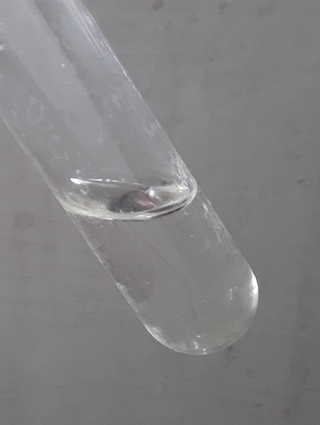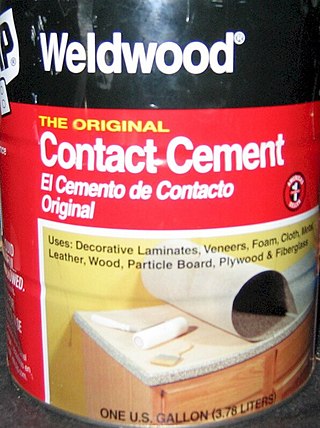
Amyl nitrite is a chemical compound with the formula C5H11ONO. A variety of isomers are known, but they all feature an amyl group attached to the nitrite functional group. The alkyl group is unreactive and the chemical and biological properties are mainly due to the nitrite group. Like other alkyl nitrites, amyl nitrite is bioactive in mammals, being a vasodilator, which is the basis of its use as a prescription medicine. As an inhalant, it also has a psychoactive effect, which has led to its recreational use, with its smell being described as that of old socks or dirty feet. It is also referred to as banapple gas.

Inhalants are a broad range of household and industrial chemicals whose volatile vapors or pressurized gases can be concentrated and breathed in via the nose or mouth to produce intoxication, in a manner not intended by the manufacturer. They are inhaled at room temperature through volatilization or from a pressurized container, and do not include drugs that are sniffed after burning or heating. For example, amyl nitrite (poppers), nitrous oxide and toluene – a solvent widely used in contact cement, permanent markers, and certain types of glue – are considered inhalants, but smoking tobacco, cannabis, and crack cocaine are not, even though these drugs are inhaled as smoke or vapor.

Recreational drug use is the use of one or more psychoactive drugs to induce an altered state of consciousness, either for pleasure or for some other casual purpose or pastime. When a psychoactive drug enters the user's body, it induces an intoxicating effect. Generally, recreational drugs are divided into three categories: depressants, stimulants, and hallucinogens.

Toluene, also known as toluol, is a substituted aromatic hydrocarbon. It is a colorless, water-insoluble liquid with the odor associated with paint thinners. It is a mono-substituted benzene derivative, consisting of a methyl group (CH3) attached to a phenyl group. As such, its systematic IUPAC name is methylbenzene. Toluene is predominantly used as an industrial feedstock and a solvent.

A solvent is a substance that dissolves a solute, resulting in a solution. A solvent is usually a liquid but can also be a solid, a gas, or a supercritical fluid. Water is a solvent for polar molecules, and the most common solvent used by living things; all the ions and proteins in a cell are dissolved in water within the cell.

In organic chemistry, xylene or xylol are any of three organic compounds with the formula (CH3)2C6H4. They are derived from the substitution of two hydrogen atoms with methyl groups in a benzene ring; which hydrogens are substituted determines which of three structural isomers results. It is a colorless, flammable, slightly greasy liquid of great industrial value.

The organic compound 1,1,1-trichloroethane, also known as methyl chloroform and chlorothene, is a chloroalkane with the chemical formula CH3CCl3. It is an isomer of 1,1,2-trichloroethane. This colorless, sweet-smelling liquid was once produced industrially in large quantities for use as a solvent. It is regulated by the Montreal Protocol as an ozone-depleting substance and its use is being rapidly phased out.

A correction fluid is an opaque, usually white fluid applied to paper to mask errors in text. Once dried, it can be handwritten or typed upon. It is typically packaged in small bottles, with lids attached to brushes that dip into the fluid. The brush applies the fluid to the paper.
A paint thinner is a solvent used to thin oil-based paints. Solvents labeled "paint thinner" are usually mineral spirits having a flash point at about 40 °C (104 °F), the same as some popular brands of charcoal starter.

Street children are poor or homeless children who live on the streets of a city, town, or village. Homeless youth are often called street kids, or urchins; the definition of street children is contested, but many practitioners and policymakers use UNICEF's concept of boys and girls, aged under 18 years, for whom "the street" has become home and/or their source of livelihood, and who are inadequately protected or supervised. Street girls are sometimes called gamines, a term that is also used for Colombian street children of either sex.

Rubber cement is an adhesive made from elastic polymers mixed in a solvent such as acetone, hexane, heptane or toluene to keep it fluid enough to be used. This makes it part of the class of drying adhesives: as the solvents quickly evaporate, the rubber solidifies, forming a strong yet flexible bond.

p-Xylene (para-xylene) is an aromatic hydrocarbon. It is one of the three isomers of dimethylbenzene known collectively as xylenes. The p- stands for para-, indicating that the two methyl groups in p-xylene occupy the diametrically opposite substituent positions 1 and 4. It is in the positions of the two methyl groups, their arene substitution pattern, that it differs from the other isomers, o-xylene and m-xylene. All have the same chemical formula C6H4(CH3)2. All xylene isomers are colorless and highly flammable. The odor threshold of p-xylene is 0.62 parts per million (ppm).
An antiknock agent is a gasoline additive used to reduce engine knocking and increase the fuel's octane rating by raising the temperature and pressure at which auto-ignition occurs. The mixture known as gasoline or petrol, when used in high compression internal combustion engines, has a tendency to knock and/or to ignite early before the correctly timed spark occurs.

Benzene is an organic chemical compound with the molecular formula C6H6. The benzene molecule is composed of six carbon atoms joined in a planar hexagonal ring with one hydrogen atom attached to each. Because it contains only carbon and hydrogen atoms, benzene is classed as a hydrocarbon.
Jenkem is an inhalant and hallucinogen created from fermented human waste. In the mid-1990s, it was reported to be a popular street drug among Zambian youth. They would reportedly put the feces and urine in a jar or a bucket and seal it with a balloon or lid respectively, then leave it out to ferment in the sun; afterwards they would inhale the fumes created.
Substance-induced psychosis is a form of psychosis that is attributed to substance use. It is a psychosis that results from the effects of chemicals or drugs. Various psychoactive substances have been implicated in causing or worsening psychosis in users.

Nitrous oxide is a gas which can induce euphoria, hallucinogenic states and relaxation when inhaled. Nitrous oxide is a neurotoxin and excessive use can cause long-term neurological damage.

Licit and Illicit Drugs: The Consumers Union Report on Narcotics, Stimulants, Depressants, Inhalants, Hallucinogens, and Marijuana–including Caffeine, Nicotine and Alcohol is a 1972 book on recreational drug use by medical writer Edward M. Brecher and the editors of Consumer Reports.
Sharkey Landfill is a 90-acre property located in New Jersey along the Rockaway and Whippany rivers in Parsippany, New Jersey. Landfill operations began in 1945, and continued until September 1972, when large amounts of toluene, benzene, chloroform, dichloroethylene, and methylene chloride were found, all of which have are a hazard to human health causing cancer and organ failure. Sharkey Landfill was put on the National Priority List in 1983, and clean up operations ran until the site was deemed as not a threat in 2004.

Impact glue, contact glue or neoprene glue, is a type of glue, used mainly to glue plastic foams, laminates, metal panels, etc. It also allows the mounting of supports of different types. Contact-type adhesives do not exclusively designate neoprene adhesives, but also all other adhesives characterized by high instant adhesion.















